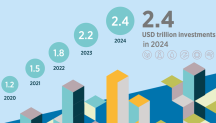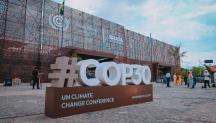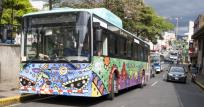

Five key policies to promote road transport electrification in developing markets
Newsletter
Road transport accounts for approximately 18% of total global CO2 emissions and is linked to a significant share of urban air pollution, as around 94% of its energy consumption globally is based on fossil fuels. Decarbonising this sector requires an accelerated electrification of light-duty vehicles, buses, trucks, two- and three-wheelers, combined with an expansion of charging infrastructure and renewables-based electricity.
For the world to be on track for achieving the Paris Climate targets, the electric vehicle (EV) fleet would need to increase eightfold in the next five years. By 2050, EVs would need to account for over 90% of global cars on the road. In 2024, there was one EV in every five cars sold. By the end of that year, global EV sales had passed 17 million, rising from just 650,000 in 2015. Most of the EVs and chargers are deployed in China, Europe and the United States while the majority of developing markets continue to lag behind due to existing barriers.
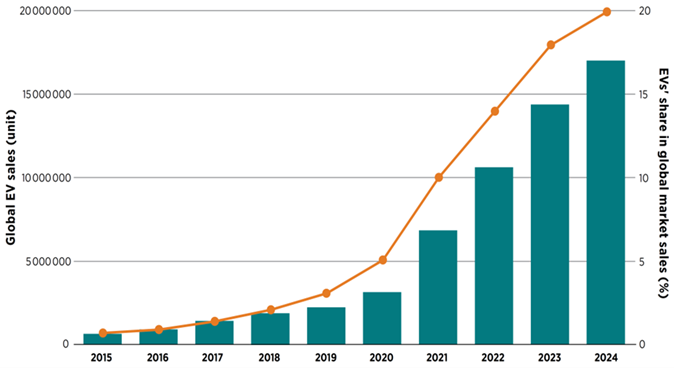
One significant barrier is that currently, EVs and charging infrastructure are beyond the affordability of developing markets, compounded by limited access to capital and finance. Targeted policies can address these and other barriers, such as financial and fiscal measures which can help improve the affordability of EVs and chargers.
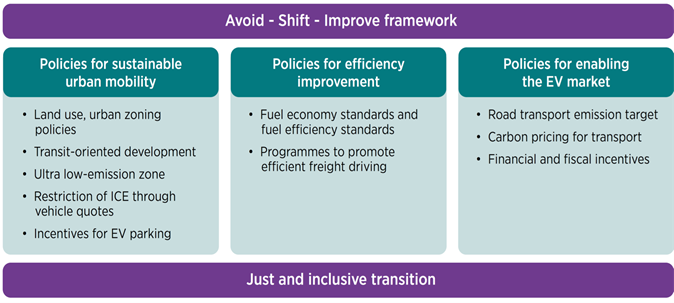
The following are five policies and measures to enable and accelerate the electrification of road transport in developing countries:
- Setting ambitious targets for EV and charging infrastructure
The adoption of ambitious targets for EV sales is an important lever to promote the transition. Based on the consideration of available resources and local context, these national or subnational targets can send clear signals to investors, industrial players and potential consumers, as well as guide investments in the needed infrastructures and improve market confidence.
Many countries and cities have announced such ambitions. Cabo Verde has set 100% EV targets for new passenger cars by 2035. Similarly, Chile has adopted targets for 100% EV sales for cars and public buses by 2035. Hainan Province (China) has set 100% EV targets for private car sales by 2030, aiming to have 45% of all cars on this island to be electric by that time.
- Promoting sustainable mobility in cities
The rapidly growing urban populations in developing markets will result in more intense transport activities and a higher level of urban air pollution linked with fossil fuels. Sustainable urban mobility requires not only the electrification of vehicles, but also the reduction of private driving. To promote sustainable mobility, cities can adopt various policies and measures. For example, promoting mixed-use urban development or compact urban design to reduce urban travel needs. When private driving cannot be avoided, cities can also implement context-based measures, such as licence plate restrictions, vehicle quotas, low-emission zones, and public parking regulations. Incentives can also be given to encourage the use of electric vehicles, consequently driving the demand for the market.
- Harnessing development financing for electric public transport projects
Modern public transport systems offer a more energy-efficient option compared to private driving, and remain the most affordable and sustainable option for communities and households that cannot afford cars. They connect people with more education opportunities, jobs, and other economic activities, and therefore playing a crucial role in sustainable development.
The procurement of electric bus fleets and related charging infrastructure often exceeds the financial capacity of developing countries. In this case, financing by development banks or multilateral development institutions can be utilised to support the deployment of electric buses and relevant charging infrastructure in these countries.
In Bogota (Colombia), the Inter-American Development Bank has provided loans for replacing diesel buses with electric ones. In Dakar (Senegal), the World Bank has provided finance for the deployment of a fully electric bus rapid transit system. In India, ADB and AIIB have provided loans to support the procurement and maintenance of 650 buses, as well as related charging infrastructure.
- Supporting innovative business models for electric two- and three-wheelers
Electric two- and three-wheelers are more affordable than cars. They play a significant role in meeting people’s essential transport needs in developing markets, such as daily commuting, taxis, and deliveries. In addition, they offer industrial development opportunities through localised manufacturing and vehicle assembly.
But affordability and access to financing for these types of vehicles can be difficult in developing markets. Innovative business models, including battery-leasing and battery-swapping models, can address the high upfront costs issue and reduce consumers’ concerns over battery maintenance or degradation.
In Kenya and Thailand, the battery swapping business makes electric two-wheelers more cost-effective than their fossil-fuel counterparts. In China, battery swapping networks have enabled delivery drivers to get their two- and three-wheelers fully charged in less than 1 minute.
- Addressing the needs of vulnerable groups affected by the transition process
In developing markets, the shift to electric vehicles may affect marginalised groups who rely on the fossil fuel-based road transport value chain, and may not be able to afford the high purchase costs of the electric alternatives. These groups – which include small transport service operators and individual workers – may also face significant income reduction during the transition process, causing some individuals and families to lose their livelihood.
To support these groups and meet their needs, policymakers should employ a more inclusive consultation and trust-building process, involving vulnerable groups working in both formal and informal sectors. An inclusive process that considers everyone’s needs and perspectives can result in affordable and accessible plans that secure people’s livelihoods, and ensure a just transition to sustainable transport.

Expert Insight by:
Jinlei Feng
Programme Officer, Policy Advice, Knowledge, Policy and Finance Centre, IRENA
© IRENA 2025
Unless otherwise stated, material in this article may be freely used, shared, copied, reproduced, printed and/or stored, provided that appropriate acknowledgement is given of the author(s) as the source and IRENA as copyright holder.
The findings, interpretations and conclusions expressed herein are those of the author(s) and do not necessarily reflect the opinions of IRENA or all its Members. IRENA does not assume responsibility for the content of this work or guarantee the accuracy of the data included herein. Neither IRENA nor any of its officials, agents, data or other third-party content providers provide a warranty of any kind, either expressed or implied, and they accept no responsibility or liability for any consequence of use of the content or material herein. The mention of specific companies, projects or products does not imply that they are endorsed or recommended, either by IRENA or the author(s). The designations employed and the presentation of material herein do not imply the expression of any opinion on the part of IRENA or the author(s) concerning the legal status of any region, country, territory, city or area or of its authorities, or concerning the delimitation of frontiers or boundaries.
